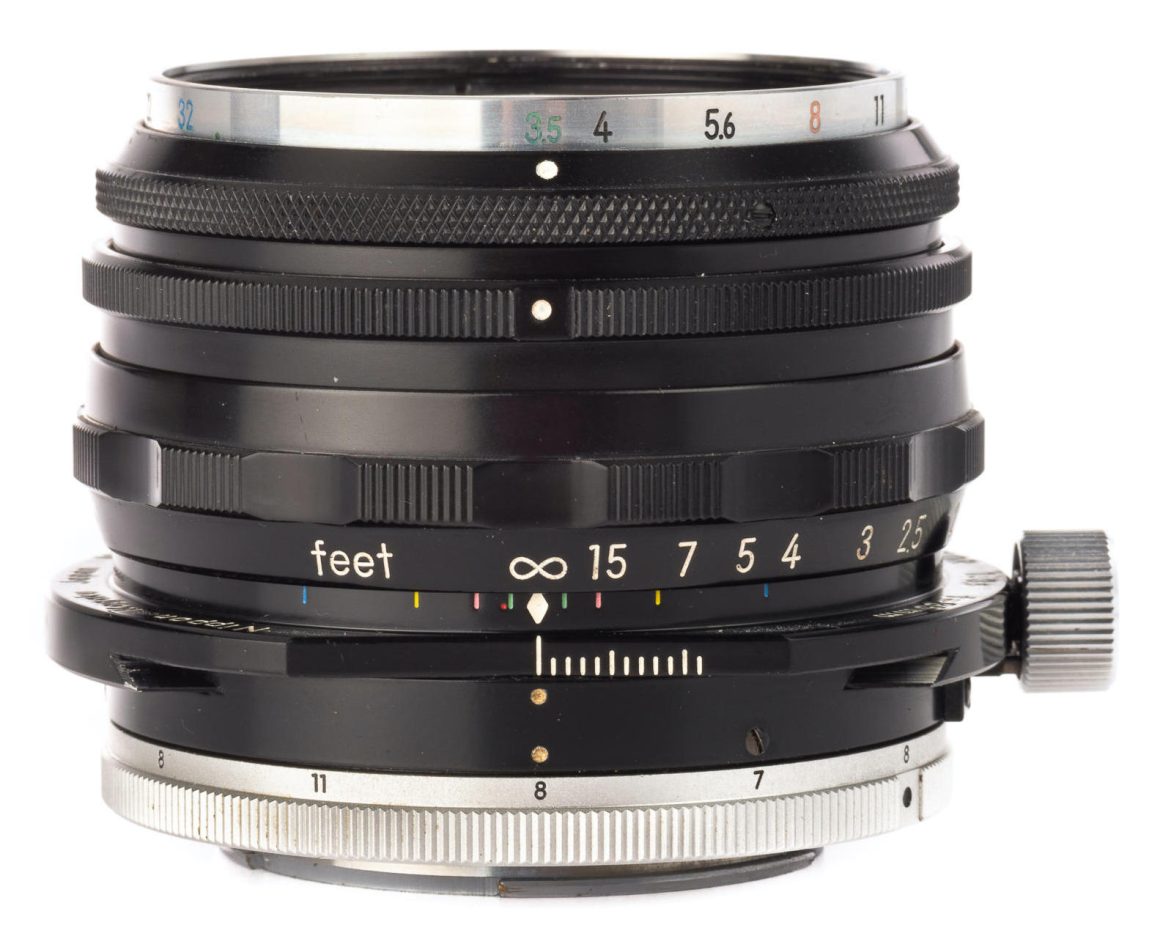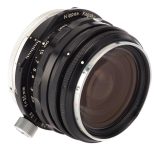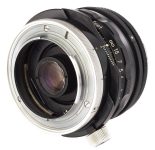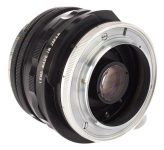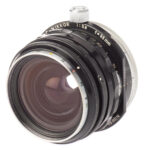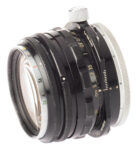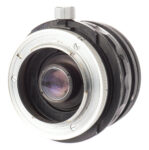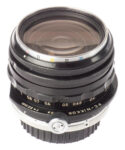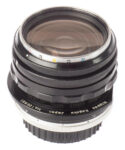Nippon Kogaku PC-Nikkor 35mm F/3.5
Shift lens • Film era • Discontinued
- Announced:
- · November 1962
- Production status:
- ● Discontinued
- Country of design:
- · Japan
- Original name:
- · Nippon Kogaku PC-NIKKOR 1:3.5 f=35mm
- Class:
- · Slow full-frame shift lens
- · Professional model (Top class)
- System:
- · Nikon F (1959)
Abbreviations
| PC | Perspective Control. |
Specification
| Optical design: | |
| 35mm full frame | |
| 35mm | |
| F/3.5 | |
| 6 elements in 6 groups | |
| Nikon F [46.5mm] | |
| 63.4° (35mm full frame) | |
| Diaphragm mechanism: | |
Diaphragm type: | Preset |
Aperture control: | Preset ring + Aperture ring |
| 6 (six) | |
| Focusing: | |
| 0.30m | |
| <No data> | |
Focusing modes: | Manual focus only |
Manual focus control: | Focusing ring |
| Perspective control mechanism: | |
Shift range: | 0..11mm |
Tilt range: | Not available |
| Yes | |
| - | |
| Physical characteristics: | |
| 290g | |
| ⌀70×52mm | |
| Accessories: | |
| Screw-type 52mm | |
| HN-1 - Screw-type round | |
| Not compatible |
Sources of data
- Manufacturer's technical data.
- Nikon for flexibility & versatility booklet.
- Nikon cameras, Nikkor lenses, Nikon accessories booklet.
- The Nikon system of photography booklet (September 1965).
Manufacturer description #1
The Nikkor perspective control lens offers the versatility of a rising and sliding front on a view camera. It provides linearity control of verticals in architectural photography. A micrometer lead-screw control permits moving optics off-center by as much as 11mm. The entire lens mount rotates 360° so correction can be made in any direction. The PC can also be used for exceptionally wide-angle coverage. Maximum aperture f3.5. Pre-set diaphragm. Accepts 52mm screw-in filters.
Manufacturer description #2
The great advantage of this lens is that the main section of the lens barrel, together with its focusing and aperture setting mechanisms, can be moved up to 11 mm parallel - with the film plane in any direction - by rotating the knob up to 3 rotations and clamping down. With this lens, it is possible to avoid the image convergence produced when the lens is not parallel to the subject extended horizontally, vertically or in any direction. Hence, the PC-Nikkor is extremely useful in architectural, industrial and commercial photography, where convergence compensation in the enlarging stage is difficult or impossible - such as in color reversal work, in which the subject is usually framed once for all exposures. Also, it makes possible a continuous wide view of two exactly matching pictures by shifting the lens without moving the camera. The PC-Nikkor expands the versatility of the 35 mm camera, and even replaces large format apparatus with "snaking" bellows. In general, the lens does away with the necessity of tilting the camera, or enables it to be tilted less. On many occasions, this makes the difference between acceptable and unaccep- table convergence of verticals.
To make the shift available to all directions, the whole front section, including the shift movement, can be rotated in the lens flange which fits into the camera body. The lens can be rotated through the entire 360° and there are click-stop settings at the twelve 30° intervals. The amount of shift is calibrated in millimeters. It is easy to set the shift to a 0.5 mm accuracy.
Therefore, in addition to the conventional rise, fall and cross movements, an infinite series of diagonal movements can be obtained. This facility to shift is sometimes very convenient; for example, when the positioning of the camera is restricted and the angle of the camera would produce unwanted distortion.
Each of the 30° rotation click-stops is calibrated with a numeral denoting the maximum shift in that direction without vignetting: 11 mm for rise and fall, 8 mm of cross, and 7 mm of diagonal shift. The extent to which the recommended shifts can be exceeded depends on the distribution of important fine detail in the subiect. When the lens is shifted downward, the cut-off at the lower end of the mirror causes considerable vignetting in the viewfinder. This, and other vignetting in the viewfinder at extreme shifts, does not appear on the negative. Therefore, the system shows no vignetting at any aperture or displacement.
The aperture diaphragm is not fully automatic, but is a manually preset type, with the preset ring at the front of the barrel and the stop-down ring immediately behind it. The preset ring and the stop-down ring rotate in the same direction. If manual presetting is not important, it is possible to adjust the preset ring to f/32, and then set the diaphragm with the stop-down ring reading on the preset scale. This aperture scale is duplicated on the other side of the lens front rim, so that settings are easily read with any shift movement. The aperture scale is linear, with a wide scale.
From the editor
World's first Perspective Control (shift) lens. The front section of the lens can be shifted up to 11mm off the central axis by sliding along on dovetail shaped rails. The lens can be rotated a full 360 degrees with click stops every 30 degrees so that shifting is possible vertically, horizontally, and diagonally. In the latter direction shift is limited to just 7cm in order to prevent vignetting.
The lens lacks Nikon Integrated Coating and suffers from mediocre sharpness and contrast as a result.
Notes
- This non-AI lens was designed for Nikon F, F2, Nikkormat FS, FT, FT2, FTN, EL, ELW 35mm film SLR cameras.
- Non-AI lenses cannot be used on Nikon digital SLR cameras (except for the Df) or late (AI) film SLR cameras. However, non-AI lenses can be fitted to Nikon FM, FE, EL2, F3, F4 and Nikkormat FT3 cameras which used the AI metering system but allowed the metering coupling lever to be disengaged. The F5 could have this mechanism fitted as an optional extra. Non-AI lenses can be also fitted to the Nikon F2A and F2AS cameras because the AI mechanism was fitted to the removable metering prism.
Other shift lenses in the Nikon F system
| ■Nikon F mount (10) | |||||||||
| Nikon PC Nikkor 19mm F/4E ED | A | 17 - 13 | 0.25m | -- | 2016 ● | ||||
| Nikon PC-E Nikkor 24mm F/3.5D ED | A | 13 - 10 | 0.21m | ⌀77 | 2008 ● | ||||
| Nikon PC-Nikkor 28mm F/4 | P | 10 - 8 | 0.30m | ⌀72 | 1975 ● | ||||
| Nikon PC-Nikkor 28mm F/3.5 | P | 9 - 8 | 0.30m | ⌀72 | 1980 ● | ||||
| Nippon Kogaku / Nikon PC-Nikkor 35mm F/2.8 | P | 8 - 7 | 0.30m | ⌀52 | 1968 ● | ||||
| Nikon PC-Nikkor 35mm F/2.8 | P | 8 - 7 | 0.30m | ⌀52 | 1975 ● | ||||
| Nikon PC-Nikkor 35mm F/2.8 | P | 7 - 7 | 0.30m | ⌀52 | 1980 ● | ||||
| Nikon PC-E Micro Nikkor 45mm F/2.8D ED | A | 9 - 8 | 0.25m | ⌀77 | 2008 ● | ||||
| Nikon PC Micro Nikkor 85mm F/2.8D | M | 6 - 5 | 0.39m | ⌀77 | 1999 ● | ||||
| Nikon PC-E Micro Nikkor 85mm F/2.8D | A | 6 - 5 | 0.39m | ⌀77 | 2008 ● | ||||
Lenses with similar focal length
| ■Nikon F mount (4) | |||||||||
| Mir-67N 35mm F/2.8 PCS MC akaArsat H 35mm F/2.8 PCS akaМИР-67Н 35mm F/2.8 ПКС МС | P | 11 - 8 | 0.30m | ⌀62 | 1990 ● | ||||
| Arax 35mm F/2.8 S&T | P | 11 - 8 | 0.30m | ⌀62 | ● | ||||
| Hartblei Super-Rotator 35mm F/2.8 TS-PC MC | M | 11 - 8 | 0.20m | ⌀82 | ● | ||||
| Hartblei Zeiss Super-Rotator 40mm F/4 IF TS | M | 12 - 9 | 0.50m | E86 | 2008 ● | ||||
| ■Interchangeable mount (2) | |||||||||
| Schneider-Kreuznach PC-Curtagon 35mm F/4 MC | M | 7 - 6 | 0.30m | ⌀49 | ● | ||||
| Schneider-Kreuznach PA-Curtagon 35mm F/4 | M | 7 - 6 | 0.30m | ⌀49 | 1967 ● | ||||
